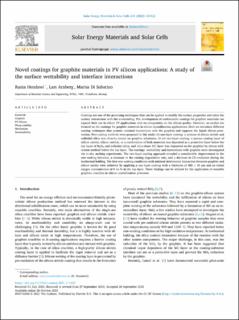| dc.contributor.author | Hendawi, Rania Tayseer Atieh | |
| dc.contributor.author | Arnberg, Lars | |
| dc.contributor.author | Di Sabatino Lundberg, Marisa | |
| dc.date.accessioned | 2023-02-13T07:41:32Z | |
| dc.date.available | 2023-02-13T07:41:32Z | |
| dc.date.created | 2021-10-27T05:19:31Z | |
| dc.date.issued | 2021 | |
| dc.identifier.citation | Solar Energy Materials and Solar Cells. 2021, 234 . | en_US |
| dc.identifier.issn | 0927-0248 | |
| dc.identifier.uri | https://hdl.handle.net/11250/3050193 | |
| dc.description.abstract | Coatings are one of the promising techniques that can be applied to modify the surface properties and tailor the surface interactions with the surrounding. The development of conformable coatings for graphite materials can expand their use in silicon PV applications with no compromise on the silicon quality. However, no studies are focused on the coatings for graphite materials in silicon crystallization applications. Here we introduce different coating techniques that promise minimal interactions with the graphite and suppress the liquid silicon penetration. Five coating methods were proposed in this study: (i) one-layer coating: a mixture of silicon nitride and colloidal silica was directly coated on graphite substrates, (ii-iv) two-layer coating: a porous coating layer of silicon nitride, silicon carbide, or a combination of both materials was deposited as a protective layer below the top layer of Si3N4 and colloidal silica, and (v) a dense SiC layer was deposited on the graphite by silicon infiltration method below the top layer. The coatings’ wettability and interactions with graphite were investigated via in-situ melting experiments. The two-layer coating approach revealed a considerable improvement in the non-wetting behavior, a decrease in the coating degradation rate, and a decrease in CO evolution during the isothermal holding. The best non-wetting conditions with minimal detrimental interaction between graphite and silicon oxides were achieved by applying a two-layer coating with a thickness of 400 ± 50 μm and an initial oxygen concentration of 8 wt.% in the top layer. These findings can be utilized for the application of reusable graphite crucibles in silicon crystallization processes. | en_US |
| dc.language.iso | eng | en_US |
| dc.publisher | Elsevier Science | en_US |
| dc.rights | Navngivelse 4.0 Internasjonal | * |
| dc.rights.uri | http://creativecommons.org/licenses/by/4.0/deed.no | * |
| dc.title | Novel coatings for graphite materials in PV silicon applications: A study of the surface wettability and interface interactions | en_US |
| dc.title.alternative | Novel coatings for graphite materials in PV silicon applications: A study of the surface wettability and interface interactions | en_US |
| dc.type | Peer reviewed | en_US |
| dc.type | Journal article | en_US |
| dc.description.version | publishedVersion | en_US |
| dc.source.volume | 234 | en_US |
| dc.source.journal | Solar Energy Materials and Solar Cells | en_US |
| dc.identifier.doi | 10.1016/j.solmat.2021.111422 | |
| dc.identifier.cristin | 1948699 | |
| dc.source.articlenumber | 111422 | en_US |
| cristin.ispublished | true | |
| cristin.fulltext | original | |
| cristin.qualitycode | 2 | |

